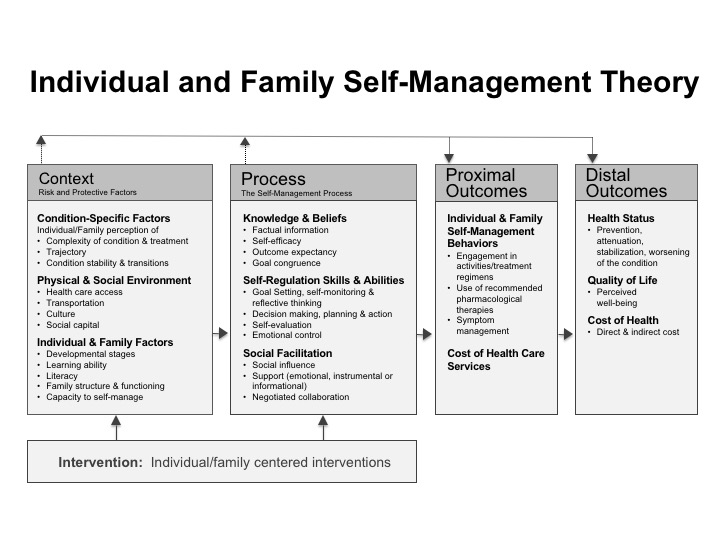The Individual and Family Self-Management Theory (IFSMT) was developed by Dr. Polly Ryan and Dr, Kathleen Sawin {1} to reflect the literature, Dr. Ryan’s work in a theory of behavior change {2}, Dr. Sawin’s work in risk and protective factors {3,4}, and interactions with scientists in the SMSC and elsewhere. Through use of the theory to guide research and continued dialogue with the scientific and practice community, the original figure was refined to the revised figure depicted below.
Self-management is defined as a process by which individuals and families use knowledge and beliefs, self-regulation skills and abilities, and social facilitation to achieve health-related outcomes. Self-management takes place in the context of risk and protective factors specific to the condition, the physical and social environment, and the individual and family. Proximal outcomes are self-management behaviors and cost of health care services; distal outcomes are health status, quality of life and cost of health. Self-management is applicable to chronic conditions as well as health promotion [1-2].
The process dimension of self-management includes the components of knowledge and beliefs, self-regulation skills and abilities, and social facilitation. The process dimension includes factors such as self-efficacy, decision-making, and collaboration. Proximal outcomes include self-management behaviors that are specific actions taken to manage the condition or to improve/maintain a healthy state. Use of health care services, such as emergency department visits or unplanned hospitalizations, are considered potential outcomes. Distal outcomes are health status, quality of life, and/or cost of health. Factors within the context and process dimensions are posited to directly or indirectly influence proximal and distal outcomes. Individual and family-centered interventions can be directed to the context or process dimensions.
The dimensions of the IFSMT are depicted in the revised figure. The context dimension consists of risk and protective factors including condition-specific factors, physical and social environments, and individual and family characteristics. The process dimension of self-management includes the components of knowledge and beliefs, self-regulation skills and abilities, and social facilitation. The process dimension includes factors such as self-efficacy, decision-making, and collaboration. Proximal outcomes include self-management behaviors that are specific actions taken to manage the condition or to improve/maintain a healthy state. Use of health care services, such as emergency department visits or unplanned hospitalizations, are considered potential outcomes. Distal outcomes are health status, quality of life, and/or cost of health. Factors within the context and process dimensions are posited to directly or indirectly influence proximal and distal outcomes. Individual and family-centered interventions can be directed to the context or process dimensions. Self-management, a multidimensional, complex phenomenon, is applicable to individuals, dyads, and families across all developmental stages to manage chronic conditions as well as engage in health promotion.

To reproduce the theory in a publication, please direct requests for permission to uwmchps@uwm.edu.
Neither the theory nor the figure is copyrighted and thus permission to use either is not needed. Drs. Ryan and Sawin encourage investigators including students to use the IFSMT to guide research. They are available to discuss the application of the IFSMT to specific research questions or aims. When using the revised figure please cite as:
Ryan, P. A., & Sawin, K. J. (2014). Individual and Family Self-Management Theory [Revised Figure]. Retrieved from https://uwm.edu/nursing/wp-content/uploads/sites/538/2021/05/IFSMT_manuscript_no_copyright_07_31_2019-002.jpg
1 Ryan, P. & Sawin, K. J. (2009). The Individual and Family Self-Management Theory: Background and perspectives on context process and outcomes. Nursing Outlook, 57, 217-225. Link to article: http://www.ncbi.nlm.nih.gov/pmc/articles/PMC2908991/
2 Ryan, P. (2009). The Integrated Theory of Health Behavior Change: Background and intervention development. Clinical Nurse Specialist, 23(3), 161-170.
3Sawin, K. J., Bellin, M. H., Roux, G., Buran, C.F. & Brei, T. J. (2009). The experience of self-management in adolescent women with spina bifida. Rehabilitation Nursing, 3427-40.
4Sawin, K. J., Buran, C. F., Brei, T. J., & Fastenau, P.S. (2003). Correlates of functional status, self-management, and developmental competence in adolescents with spina bifida. SCI Nursing, 20(2), 72-86.